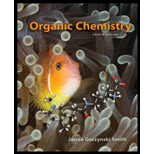
Concept explainers
Draw the organic product formed when the amino acid leucine is treated with each reagent.
a.
b.
c.
d.
e.
f.
(a)
Interpretation: The organic product formed by the treatment of amino acid leucine with the given reagent is to be drawn.
Concept introduction: The chemical compounds in which carbon is bonded with acidic and basic group along with hydrocarbon side chain are known as amino acids. The amino acids are classified into acidic, basic, polar, non-polar, essential, and non-essential categories. The three word abbreviation or one word abbreviation is used for amino acids.
Answer to Problem 29.40P
The organic product formed by the treatment of amino acid leucine with the given reagent is drawn below.

Explanation of Solution
The given reagent is
The reaction between leucine and

Figure 1
Thus, the organic product formed by the treatment of amino acid leucine with the given reagent is,
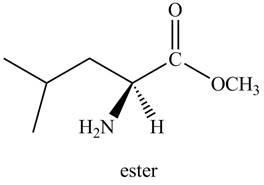
Figure 2
The organic product formed by the treatment of amino acid leucine with the given reagent is drawn in Figure 2.
(b)
Interpretation: The organic product formed by the treatment of amino acid leucine with the given reagent is to be drawn.
Concept introduction: The chemical compounds in which carbon is bonded with acidic and basic group along with hydrocarbon side chain are known as amino acids. The amino acids are classified into acidic, basic, polar, non-polar, essential, and non-essential categories. The three word abbreviation or one word abbreviation is used for amino acids.
Answer to Problem 29.40P
The organic product formed by the treatment of amino acid leucine with the given reagent is drawn below.

Explanation of Solution
The given reagent is
The treatment of leucine with
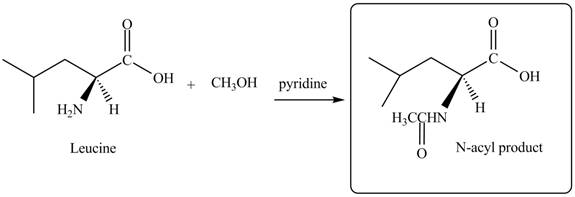
Figure 3
Thus, the organic product formed by the treatment of amino acid leucine with the given reagent is,

Figure 4
The organic product formed by the treatment of amino acid leucine with the given reagent is drawn in Figure 4.
(c)
Interpretation: The organic product formed by the treatment of amino acid leucine with the given reagent is to be drawn.
Concept introduction: The chemical compounds in which carbon is bonded with acidic and basic group along with hydrocarbon side chain are known as amino acids. The amino acids are classified into acidic, basic, polar, non-polar, essential, and non-essential categories. The three word abbreviation or one word abbreviation is used for amino acids.
Answer to Problem 29.40P
The organic product formed by the treatment of amino acid leucine with the given reagent is drawn below.
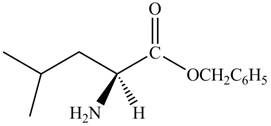
Explanation of Solution
The given reagent is
The reaction between leucine and

Figure 5
Thus, the organic product formed by the treatment of amino acid leucine with the given reagent is,
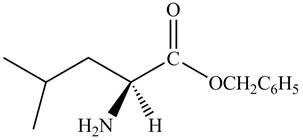
Figure 6
The organic product formed by the treatment of amino acid leucine with the given reagent is drawn in Figure 6.
(d)
Interpretation: The organic product formed by the treatment of amino acid leucine with the given reagent is to be drawn.
Concept introduction: The chemical compounds in which carbon is bonded with acidic and basic group along with hydrocarbon side chain are known as amino acids. The amino acids are classified into acidic, basic, polar, non-polar, essential, and non-essential categories. The three word abbreviation or one word abbreviation is used for amino acids.
Answer to Problem 29.40P
The organic product formed by the treatment of amino acid leucine with the given reagent is drawn below.
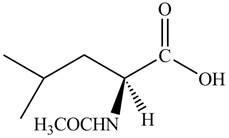
Explanation of Solution
The given reagent is
The reaction between leucine and
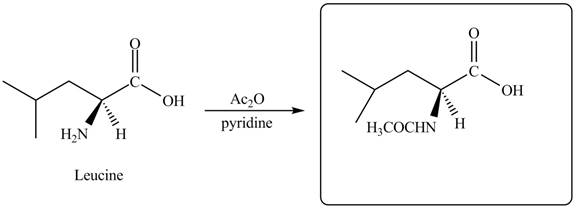
Figure 7
Thus, the organic product formed by the treatment of amino acid leucine with the given reagent is,
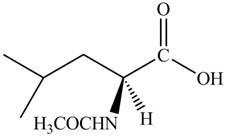
Figure 8
The organic product formed by the treatment of amino acid leucine with the given reagent is drawn in Figure 8.
(e)
Interpretation: The organic product formed by the treatment of amino acid leucine with the given reagent is to be drawn.
Concept introduction: The chemical compounds in which carbon is bonded with acidic and basic group along with hydrocarbon side chain are known as amino acids. The amino acids are classified into acidic, basic, polar, non-polar, essential, and non-essential categories. The three word abbreviation or one word abbreviation is used for amino acids.
Answer to Problem 29.40P
The organic product formed by the treatment of amino acid leucine with the given reagent is drawn below.
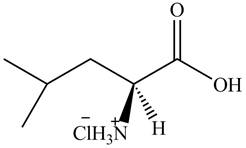
Explanation of Solution
The given reagent is
The reaction between leucine and
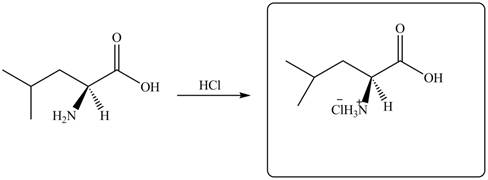
Figure 9
Thus, the organic product formed by the treatment of amino acid leucine with the given reagent is,

Figure 10
The organic product formed by the treatment of amino acid leucine with the given reagent is drawn in Figure 10.
(f)
Interpretation: The organic product formed by the treatment of amino acid leucine with the given reagent is to be drawn.
Concept introduction: The chemical compounds in which carbon is bonded with acidic and basic group along with hydrocarbon side chain are known as amino acids. The amino acids are classified into acidic, basic, polar, non-polar, essential, and non-essential categories. The three word abbreviation or one word abbreviation is used for amino acids.
Answer to Problem 29.40P
The organic product formed by the treatment of amino acid leucine with the given reagent is drawn below.
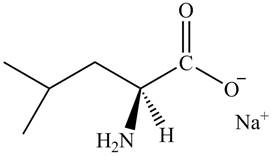
Explanation of Solution
The given reagent is
The reaction between leucine and

Figure 11
Thus, the organic product formed by the treatment of amino acid leucine with the given reagent is,

Figure 12
The organic product formed by the treatment of amino acid leucine with the given reagent is drawn in Figure 12.
(g)
Interpretation: The organic product formed by the treatment of amino acid leucine with the given reagent is to be drawn.
Concept introduction: The chemical compounds in which carbon is bonded with acidic and basic group along with hydrocarbon side chain are known as amino acids. The amino acids are classified into acidic, basic, polar, non-polar, essential, and non-essential categories. The three word abbreviation or one word abbreviation is used for amino acids.
Answer to Problem 29.40P
The organic product formed by the treatment of amino acid leucine with the given reagent is drawn below.

Explanation of Solution
The given reagent is
The reaction between leucine and

Figure 13
Thus, the organic product formed by the treatment of amino acid leucine with the given reagent is,
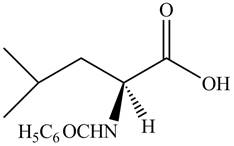
Figure 14
The organic product formed by the treatment of amino acid leucine with the given reagent is drawn in Figure 14.
(h)
Interpretation: The organic product formed by the treatment of amino acid leucine with the given reagent is to be drawn.
Concept introduction: The chemical compounds in which carbon is bonded with acidic and basic group along with hydrocarbon side chain are known as amino acids. The amino acids are classified into acidic, basic, polar, non-polar, essential, and non-essential categories. The three word abbreviation or one word abbreviation is used for amino acids.
Answer to Problem 29.40P
The organic product formed by the treatment of amino acid leucine with the given reagent is drawn below.

Explanation of Solution
The given reagent is
The reaction between leucine and

Figure 15
Thus, the organic product formed by the treatment of amino acid leucine with the given reagent is,

Figure 16
The organic product formed by the treatment of amino acid leucine with the given reagent is drawn in Figure 16.
(i)
Interpretation: The organic product formed by the treatment of amino acid leucine with the given reagent is to be drawn.
Concept introduction: The chemical compounds in which carbon is bonded with acidic and basic group along with hydrocarbon side chain are known as amino acids. The amino acids are classified into acidic, basic, polar, non-polar, essential, and non-essential categories. The three word abbreviation or one word abbreviation is used for amino acids.
Answer to Problem 29.40P
The organic product formed by the treatment of amino acid leucine with the given reagent is drawn below.
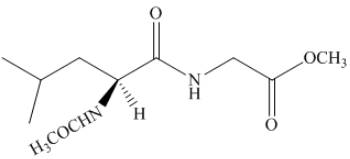
Explanation of Solution
The given reagent is
The structure of product in (d) is shown below.
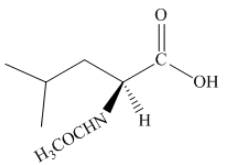
Figure 8
The reaction between leucine and
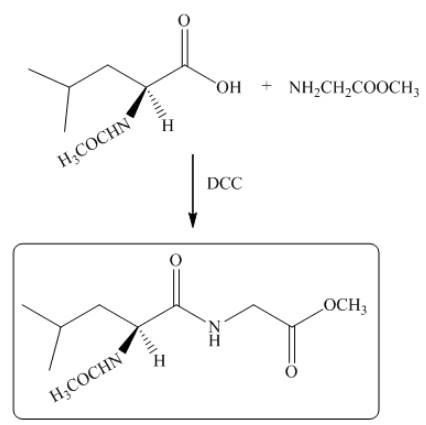
Figure 17
Thus, the organic product formed by the treatment of amino acid leucine with the given reagent is,

Figure 18
The organic product formed by the treatment of amino acid leucine with the given reagent is drawn in Figure 18.
(j)
Interpretation: The organic product formed by the treatment of amino acid leucine with the given reagent is to be drawn.
Concept introduction: The chemical compounds in which carbon is bonded with acidic and basic group along with hydrocarbon side chain are known as amino acids. The amino acids are classified into acidic, basic, polar, non-polar, essential, and non-essential categories. The three word abbreviation or one word abbreviation is used for amino acids.
Answer to Problem 29.40P
The organic product formed by the treatment of amino acid leucine with the given reagent is drawn below.
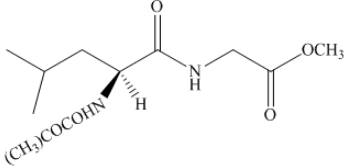
Explanation of Solution
The given reagent is
The structure of product in (h) is shown below.

Figure 16
The reaction between leucine and
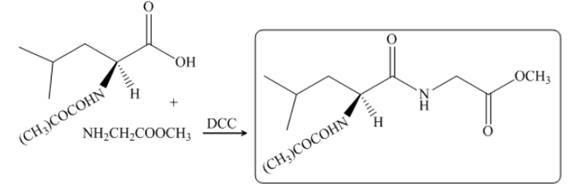
Figure 19
Thus, the organic product formed by the treatment of amino acid leucine with the given reagent is,
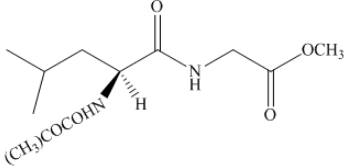
Figure 20
The organic product formed by the treatment of amino acid leucine with the given reagent is drawn in Figure 20.
(k)
Interpretation: The organic product formed by the treatment of amino acid leucine with the given reagent is to be drawn.
Concept introduction: The chemical compounds in which carbon is bonded with acidic and basic group along with hydrocarbon side chain are known as amino acids. The amino acids are classified into acidic, basic, polar, non-polar, essential, and non-essential categories. The three word abbreviation or one word abbreviation is used for amino acids.
Answer to Problem 29.40P
The organic product formed by the treatment of amino acid leucine with the given reagent is drawn below.
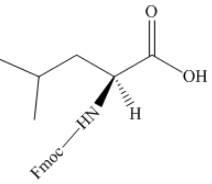
Explanation of Solution
The given reagent is
The reaction between leucine and
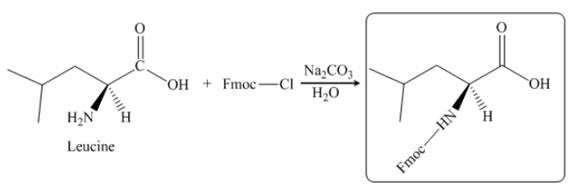
Figure 21
Thus, the organic product formed by the treatment of amino acid leucine with the given reagent is,

Figure 22
The organic product formed by the treatment of amino acid leucine with the given reagent is drawn in Figure 22.
(l)
Interpretation: The organic product formed by the treatment of amino acid leucine with the given reagent is to be drawn.
Concept introduction: The chemical compounds in which carbon is bonded with acidic and basic group along with hydrocarbon side chain are known as amino acids. The amino acids are classified into acidic, basic, polar, non-polar, essential, and non-essential categories. The three word abbreviation or one word abbreviation is used for amino acids.
Answer to Problem 29.40P
The organic product formed by the treatment of amino acid leucine with the given reagent is drawn below.
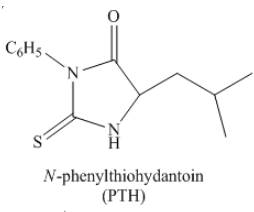
Explanation of Solution
The given reagent is
The reaction between leucine and
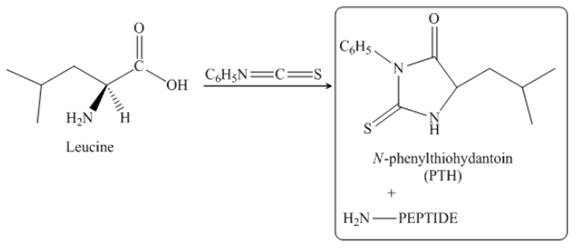
Figure 23
Thus, the organic product formed by the treatment of amino acid leucine with the given reagent is,
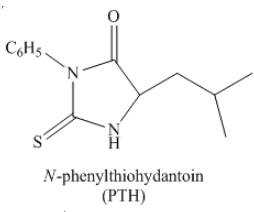
Figure 24
The organic product formed by the treatment of amino acid leucine with the given reagent is drawn in Figure 24.
Want to see more full solutions like this?
Chapter 29 Solutions
Package: Organic Chemistry With Connect 2-semester Access Card
- Draw zwitterion forms of these amino acids. (a) Valine (b) Phenylalanine (c) Glutaminearrow_forward16*32 Many tumors of the breast are correlated with estrogen levels in the body. Drugs that interfere with estrogen binding have antitumor activity and may even help prevent tumor occurrence. A widely used antiestrogen drug is tamoxifen. kJ1 Name the functional groups in tamoxifen. Classify the amino group in tamoxifen as primary, secondary, or tertiary. How many stereoisomers are possible for tamoxifen? (d, Would you expect tamoxifen to be soluble or insoluble in water? In blood?arrow_forward22-21 Explain why an amino acid cannot exist in an un-ionized form at any pH.arrow_forward
- What characteristics indicate that amino acids exist as zwitterions?arrow_forwardWhich of the following are true concerning the chemical bond that forms between the carboxyl (RCOOH) group of one amino acid and the amino (RCNH2) group of another? a.The bond is called a peptide bond. b.It is formed by inserting a water molecule between them. c.It is formed by a dehydration reaction. d.A polypeptide has more of these bonds than a protein.arrow_forwardDraw the structure of a naturally occurring amino acid that: a. contains a 1 ° alcohol b. contains an amide c. is an essential amino acid with an aromatic ring d. is a neutral amino acid with a 3 ° carbon atom in its side chainarrow_forward
- Draw the product formed when the following amino acid is treated with each reagent: (a) CH3OH, H+; (b) CH3COCCl, pyridine; (c) HCl (1 equiv); (d) NaOH (1 equiv); (e) C6H5N = C = S.arrow_forward1. A. Draw the structure of L-valine in a strongly basic solution. B. What is the charge of this amino acid in a strongly basic solution?arrow_forwardAbove is an uncommon amino acid called dehydrobuyterine. Three parts of the molecule are circled. Question 6.1 C The red circle (C) represents: :the side chain :the alpha carbon :the backbone Question 6.2 B Q6.2 B The blue shape (B) represents: :the side chainChoice :the backbone :the alpha carbon Question 6.3 A Q6.3 A The green shape (A) represents: :the side chain :the backbone :the alpha carbonarrow_forward
- Draw each amino acid in its dipolar ion form. a. Val b. Phe c. Tyr d. Cysarrow_forwardDraw zwitterion forms of these amino acids. (a) Valine (b) Phenylalanine (c) Glutaminearrow_forwardWhich amino acids could be referred to as derivatives of butanoic acid? Give their structures. Draw the amino acid in zwitterion form. Draw one structure per sketcher. Add additional sketchers using the drop-down menu in the bottom right corner. Separate structures with + signs from the drop-down menu.arrow_forward
 Organic ChemistryChemistryISBN:9781305580350Author:William H. Brown, Brent L. Iverson, Eric Anslyn, Christopher S. FootePublisher:Cengage Learning
Organic ChemistryChemistryISBN:9781305580350Author:William H. Brown, Brent L. Iverson, Eric Anslyn, Christopher S. FootePublisher:Cengage Learning
 Organic And Biological ChemistryChemistryISBN:9781305081079Author:STOKER, H. Stephen (howard Stephen)Publisher:Cengage Learning,
Organic And Biological ChemistryChemistryISBN:9781305081079Author:STOKER, H. Stephen (howard Stephen)Publisher:Cengage Learning, General, Organic, and Biological ChemistryChemistryISBN:9781285853918Author:H. Stephen StokerPublisher:Cengage Learning
General, Organic, and Biological ChemistryChemistryISBN:9781285853918Author:H. Stephen StokerPublisher:Cengage Learning World of Chemistry, 3rd editionChemistryISBN:9781133109655Author:Steven S. Zumdahl, Susan L. Zumdahl, Donald J. DeCostePublisher:Brooks / Cole / Cengage Learning
World of Chemistry, 3rd editionChemistryISBN:9781133109655Author:Steven S. Zumdahl, Susan L. Zumdahl, Donald J. DeCostePublisher:Brooks / Cole / Cengage Learning Chemistry for Today: General, Organic, and Bioche...ChemistryISBN:9781305960060Author:Spencer L. Seager, Michael R. Slabaugh, Maren S. HansenPublisher:Cengage Learning
Chemistry for Today: General, Organic, and Bioche...ChemistryISBN:9781305960060Author:Spencer L. Seager, Michael R. Slabaugh, Maren S. HansenPublisher:Cengage Learning





